 |
 |
| "A world where equity is at the root of a dynamic harmony between peoples and nature, as well as among peoples..." |

 |
||||
|
Comments from the Chair: Aroha Te Pareake Mead
It's hard to imagine that 4 years has already passed since I was elected Chair of CEESP at the WCC in 2009. What an amazing experience it has been! In the course of this work, I've had the privilege of meeting so many incredible people doing incredible things for nature, for communities, for humanity. The joy of being enriched by an ever increasing network of respected friends and colleagues is only dimmed when someone is lost. Sadly, CEESP lost two very valuable members in the space of two weeks. |
||||
 |
||||
 |
||||
|
|
||||
 |
||||
 |
||||
In Memoriam A Tribute to Professor Emmanuel Asuquo Obot Democratising the commons: Elinor Ostrom and the work of SUSG |
||||
 |
||||
 |
||||
CEESP @ The World Conservation Congress For those members who are attending the World Conference Congress in Jeju next month, we have established a special webpage to share the latest updates on the WCC and to highlight information of particular interest to CEESP.
Key dates for CEESP include:
All CEESP members are invited to participate in the Members meeting, taking place in the Jeju International Convention Centre on Thursday 6th September. This is an opportunity to meet and network with fellow CEESP members face to face. It is a time to hear about progress and celebrate achievements, to identify gaps and work to be done and consider how CEESP and individual members can contribute to the way forward in the next four years.
Click below to view the flyers for these key events:
CEESP Youth Network at Congress CEESP Youth Network members are actively involved in the preparation of World Conservation Congress events in Jeju. In April we submitted a successful proposal to the International Development and Research Centre (IDRC) thanks to the collaboration of Peggy Smith from Lakehead University and vice-Chair of CEESP North America and Caribbean Region (project coordinator) and the Canadian Committee for the IUCN. The proposal will cover a part of the costs associated with travel for 6 young professionals, including a member of the fishing community of Tárcoles in Costa Rica. |
||||
 |
||||
 |
||||
CEESP The Rio+20 Conference
This section provides reports from a range of CEESP members who participated in various activities within the hectic Rio+20 calendar of events.
Rio +20 Report: From the fault Lines of the Green Economy
Un cálido y bello Río de Janeiro atendió a más de 50.000 personas que asistimos a la Conferencia para el Desarrollo Sostenible de las Naciones Unidas con grandes expectativas para el trabajo y los planteamientos concretos para la acción global en referencia a dos objetivos particulares:
ICCA Consortium at Rio+20: time to learn, time to think strategy...
We organized and held our events, met colleagues, discussed issues to the point of losing our voice, attended gathering, events and protest marches, did some strategic thinking and planning and went back home... all with hardly a glance at the gathering of the State parties that embarked on the long and painful effort you all know about, generally described as worthless by most of the reports and the media.
Compared to the close attention and energy we are used to place into official wording at gatherings such as CBD's COPs or IUCN World Conservation Congresses, it did feel strange indeed.
The event was organized by the government of Perú, where as representatives of CASSE we participate with the poster Economic growth policies threats mountain ecosystems in South America: lessons for the endless growing world, about mining effects in mountain areas with study cases from Brazil and Colombia.
The poster focused in the social and environmental effects that the extractive activities of mining (iron, coal and gold) are causing in those South American countries, and its relation with the global economic trends since mining is an important sector for the economic development of these countries.
Honoring Communities on the Frontlines of Sustainable Development
Forest People programme Report in Rio
|
||||
 |
||||
 |
||||
Your Contribution NeededCEESP Youth network needs your help in completing a survey on "Youth Engagement and Intergenerational Partnerships: Towards an IUCN-wide Action Plan". Youth Engagement and Intergenerational Partnerships: Towards an IUCN-wide Action Plan The CEESP Youth Network needs your help to complete a survey.
The goal of this survey is to collect ideas from youth across IUCN Commissions for an Action Plan to be formalized at the IUCN World Conservation Congress, to be held in Jeju, South Korea during September 2012.
The Action Plan is an expected outcome of the "Youth Engagement and Intergenerational Partnerships: Towards an IUCN-wide Action Plan". The Action Plan will include both IUCN-wide plans as well as Commission-specific plans.
Your comments are sought on the draft version of Governance of Protected Areas: from Understanding to Action
The document has been developed as a response to a call from the Parties to the Convention on Biological Diversity (CBD) for: 'resources, tools and capacity development around Protected Area Governance', to further the implementation of the CBD Programme of Work on Protected Areas (POWPA). The 'Element on Governance, Equity and Rights' of the POWPA in particular remains the least implemented. This led the Parties and Secretariat to feel the need for support resources and a more systematic approach to 'assessing and improving PA governance'. This document is specifically designed to contribute to this. The document contains: An overview of the concepts and scope of "governance of protected areas" An overall framework to assess and evaluate governance: at the level of protected area systems and at the level of protected area sites The document will be published as one of the IUCN WCPA Best Practice Guidelines, and is a collaborative effort of the ICCA Consortium and the IUCN Protected Areas Programme, GIZ, CEESP, WCPA and the CBD Secretariat. |
||||
 |
||||
 |
||||
|
CEESP News & Updates Shifting Cultivation, Gender and REDD+ in West and Central Africa
Coastal Youth Workshop, Costa Rica
Protecting our Natural Heritage
As I write this the planet is being devastated by both droughts and floods. In the United States the worse droughts and heat waves have caused devastating effects on the land, agriculture and health of the people. Agricultural produce has declined as the weather takes their toll. The price of basic food such as corn, soybeans and wheat have increased as the demand out strips the supply. The heat wave and drought has reached temperatures of over 100 degrees Fare height thereby destroying the corn belt of the US.
Update on Whakatane Mechanism - Feedback Welcomed - French & Spanish versions follow
Commentaires des Membres de l'UICN sur le Cadre du Mécanisme de Whakatane French - Le Mécanisme de Whakatane, une initiative « Un seul Programme » de l'UICN dans laquelle CEESP est fortement impliquée, vise à s'assurer que les politiques et pratiques de conservation respectent les droits des peuples autochtones et des communautés locales, notamment les droits consacrés par la Déclaration des Nations Unies sur les droits des peuples autochtones (UNDRIP). Il s'agit d'un instrument pour la mise en œuvre de la Résolution 4.052 de l'UICN et d'autres résolutions prises par le Congrès mondial de la nature en faveur du respect des droits des peuples autochtones et des communautés locales dans le domaine de la conservation.
Comentarios de los miembros de la UICN sobre el Marco para el Mecanismo de Whakatane Spanish - La finalidad del Mecanismo de Whakatane, una iniciativa de la UICN bajo su enfoque de « Un solo Programa» en la que la CPAES está muy involucrada, es asegurar que las políticas y prácticas de conservación respetan los derechos de los pueblos indígenas y las comunidades locales, incluidos los especificados en laDeclaración de las Naciones Unidas sobre los derechos de los pueblos indígenas (DNUDPI). Se trata de una herramienta para poner en práctica la resolución 4.052 de la UICN y otras resoluciones tomadas en el Congreso Mundial de la Naturaleza para que se respeten los derechos de los pueblos indígenas y las comunidades locales en las prácticas de conservación.
CBD preparatory meeting for indigenous peoples in Africa
The Convention on Biological Diversity organised a preparatory workshop for more than fifty African indigenous and local community activists ahead of the 11th Conference of Parties.
TEMTI Series - Analytical Perspectives on Global Sustainability The CEESP Theme on the Environment, Macroeconomics, Trade and Investment (TEMTI) will be launching a new TEMTI Series called Analytical Perspectives on Global Sustainability. The objective of this new series is to provide material for the analysis and interpretation of current problems concerning social and environmental sustainability at national and global levels. TGER-Four Year Report to IUCN CEESP Chair and SC, 2009-2012
Report from Sustainable Use & Livelihoods (SULi)
|
||||
 |
||||
 |
||||
|
CEESP Publications & Resources Planning adaptation for food and farming: lessons from 40 years’ research
This holistic approach must also be applied to economic analysis on adaptation planning. Similarly, it is vital to use traditional knowledge and management skills, which can further support adaptation planning. Taking these lessons into account, we can then address the emerging policy challenges that we face.
Putting citizens at the heart of food system governance
Biodiversity and culture: exploring community protocols, rights and consent
Edited by: Krystyna Swiderska (IIED), Kanchi Kohli (Kalpavriksh, India), Harry Jonas and Holly Shrumm (Natural Justice), Wim Hiemstra, (COMPAS, Netherlands), Maria Julia Oliva (Union for Ethical Biotrade)
In recent years, community biocultural protocols and Free Prior Informed Consent have been recognised as important tools to help indigenous peoples and local communities to safeguard their rights to land and natural resources.
But the practicalities of how to develop, use and support these tools have been less well understood.
Two new reports on The Conservation Initiative on Human Rights (CIHR) Consortium The Conservation Initiative on Human Rights (CIHR) consortium has recently published two reports in support of its goal to promote integration of human rights in conservation policy and practice.
Environmental assessments: biodiversity and indigenous people at risk Though Environmental Impact Assessments (EIAs) and Environmental and Social Impact Assessments (ESIAs) can be useful tools they often fail to protect biodiversity and indigenous people. This paper describes some of the reasons and suggests some solutions. The International Association for Impact Assessment (IAIA) defines an environmental impact assessment as "the process of identifying, predicting, evaluating and mitigating the biophysical, social, and other relevant effects of development proposals prior to major decisions being taken and commitments made. Protecting Indigenous Rights in Development Initiatives
One of the best strategies we can use is to demand that all development initiatives respect our human rights.
Protected Landscapes and Wild Biodiversity
Peoples Under Threat around the world: Interactive Map (The Guardian) A history of cattle raiding between the Lou Nuer and the Murle, as well as other groups, has developed into inter-communal violence affecting 120,000 people, and tens of thousands of refugees have also fled across the border in recent months.
Our Country Our Way: Guidelines for Australian Indigenous Protected Area Management Plans
Development of Linked Cultural and Biophysical Indicators for the Wet Tropics World Heritage Area
'Bitter Seeds' documentary reveals tragic toll of GMOs in India
Financialisation, Biodiversity Conservation and Equity: Some currents and concerns
This has generated a fizz of interest around what might constitute innovative financing mechanisms for biodiversity.
Indigenous Communities, the Bioeconomy and Natural Resource Development
Pimachiowin Aki "The Land that Gives Life" Cultural Landscape Atlas
|
||||
 |

Book Reviews
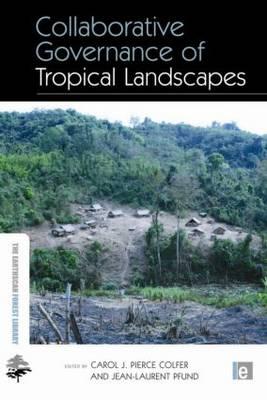 Governance is a pivotal aspect of natural resource management initiatives. The landscape management approach is a growing trend in tackling the challenges of connectivity (not only bio-physical but also cultural, social and economic) and the nexus of biodiversity conservation and human development at a larger scale.
Governance is a pivotal aspect of natural resource management initiatives. The landscape management approach is a growing trend in tackling the challenges of connectivity (not only bio-physical but also cultural, social and economic) and the nexus of biodiversity conservation and human development at a larger scale.
Thus, the overall topic of this book "collaborative governance of landscapes" combines two currently very important aspects of natural resource management that need further and continuing understanding worldwide.
The book draws upon lessons from applied research and learning-by-doing interventions of a multi-country interdisciplinary study coordinated by the Center for International Forest Research (CIFOR) – the Landscape Mosaics Project. Chapters describe studies in several cultural contexts whilst addressing different aspects of governance.
Forests and Climate Change: The Social Dimensions of REDD in Latin America, reviewed by Janis Alcorn
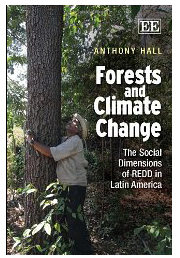 Professor Anthony Hall presents an excellent analysis of REDD+ social dimensions, including detailed discussions of the roles of governance and institutional choices, nesting, economics (learning from PES, conditional cash transfers etc), and livelihoods -- all aspects essential for REDD+ to raise the bar to achieve social development and carbon sequestration in diverse circumstances, rather than opting for the lower bar of incorporating social concerns into blueprint approaches aiming to prevent REDD+ harms through social safeguards.
Professor Anthony Hall presents an excellent analysis of REDD+ social dimensions, including detailed discussions of the roles of governance and institutional choices, nesting, economics (learning from PES, conditional cash transfers etc), and livelihoods -- all aspects essential for REDD+ to raise the bar to achieve social development and carbon sequestration in diverse circumstances, rather than opting for the lower bar of incorporating social concerns into blueprint approaches aiming to prevent REDD+ harms through social safeguards.


IUCN Newsletters
IUCN SCC Bulletin |
CEC Newsletter
|
CEM Newsletter |
CEL Newsletter |
WCPA Newsletter |
Business & Biodiversity Newsletter |

| "A world where cultural diversity is intertwined with biological diversity and both generate abundant livelihoods opportunities." |
Commission on Environmental, |

 In a few weeks the world's conservation community will converge in Jeju, South Korea for the World Conservation Congress. This is a rare opportunity for IUCN member organisations, the Secretariat and Commission members to meet together to report on achievements, elect a new President, Council and Commission Chairs and most importantly plan for the future.
In a few weeks the world's conservation community will converge in Jeju, South Korea for the World Conservation Congress. This is a rare opportunity for IUCN member organisations, the Secretariat and Commission members to meet together to report on achievements, elect a new President, Council and Commission Chairs and most importantly plan for the future. 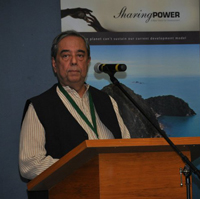 A Sustainable World must, by definition, be a Renewable World. A renewable world is one in which the world's natural capital is used without being used up. It draws its sustenance freely from nature's resources, but without depleting them to a point where they are no longer available or affordable. A Renewable World must, in practice, be a Fair World. Extremes of affluence and poverty are not compatible with the imperatives of a renewable or sustainable world. The very rich tend to over utilize those resources (usually of ancient origin such as minerals, fossil fuels, virgin forests and environmental sinks) that cannot be replaced and the very poor have to survive by over dependence on living resources (such as soils, waters and biomass) that can then no longer regenerate themselves. The limits of nature are inherently and inexorably transgressed by both the diseases, affluenza and povertitis, conditions that are now clearly terminal.
A Sustainable World must, by definition, be a Renewable World. A renewable world is one in which the world's natural capital is used without being used up. It draws its sustenance freely from nature's resources, but without depleting them to a point where they are no longer available or affordable. A Renewable World must, in practice, be a Fair World. Extremes of affluence and poverty are not compatible with the imperatives of a renewable or sustainable world. The very rich tend to over utilize those resources (usually of ancient origin such as minerals, fossil fuels, virgin forests and environmental sinks) that cannot be replaced and the very poor have to survive by over dependence on living resources (such as soils, waters and biomass) that can then no longer regenerate themselves. The limits of nature are inherently and inexorably transgressed by both the diseases, affluenza and povertitis, conditions that are now clearly terminal. 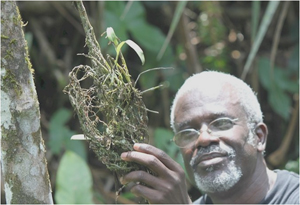 The IUCN community is deeply saddened by the sudden loss of our colleague and friend Professor Emmanuel Asuquo Obot who died tragically on Sunday 3 June 2012 in the plane crash in Lagos, Nigeria. Professor Obot was the Executive Director of the Nigerian Conservation Foundation, an IUCN Member organization, a Steering Committee member of the Commission on Environmental Economic and Social Policy (CEESP) and Chair of the CEESP Theme on Social and Environmental Accountability of the Private Sector (SEAPRISE).
With a doctorate in botany and a passion for orchids, Professor Obot was one of Nigeria's most respected scientists. He worked for thirty years on the design and implementation of environmentally sustainable community-based development projects with the objective of providing access rights and secure land tenure to local people(s). He sought to develop and apply the concept of participatory management of renewable natural resources with local people living around protected areas in Nigeria. He developed and tested "governance" structures that allow communities living in close proximity to National Parks to "have a voice" and contribute to the management of the Parks. The establishment of the Cross River National Park is one of his greatest legacies.
The IUCN community is deeply saddened by the sudden loss of our colleague and friend Professor Emmanuel Asuquo Obot who died tragically on Sunday 3 June 2012 in the plane crash in Lagos, Nigeria. Professor Obot was the Executive Director of the Nigerian Conservation Foundation, an IUCN Member organization, a Steering Committee member of the Commission on Environmental Economic and Social Policy (CEESP) and Chair of the CEESP Theme on Social and Environmental Accountability of the Private Sector (SEAPRISE).
With a doctorate in botany and a passion for orchids, Professor Obot was one of Nigeria's most respected scientists. He worked for thirty years on the design and implementation of environmentally sustainable community-based development projects with the objective of providing access rights and secure land tenure to local people(s). He sought to develop and apply the concept of participatory management of renewable natural resources with local people living around protected areas in Nigeria. He developed and tested "governance" structures that allow communities living in close proximity to National Parks to "have a voice" and contribute to the management of the Parks. The establishment of the Cross River National Park is one of his greatest legacies. Sometime in the mid-1990s, during the initial heyday of expansion in Zimbabwe's CAMPFIRE Programme, I took part in a review meeting on its origins and progress, attended by many who had been involved in its inception. Regarding its conceptual origins, one scholar-practitioner remarked that Common Property Theory had played no role in its origins; CAMPFIRE was a Zimbabwean response to Zimbabwean problems, shaped by Zimbabwean analyses. The remark was made out of ignorance, not malice, but it was nevertheless symptomatic of the gulf that has existed for too long between the world of professional scholars and planners who shape policy in the abstract and those who modify and implement policy in the grounded reality where they live and work, not only on Zimbabwe but around the world.
The scholarship of the American Elinor Ostrom, who died in June of this year at the age of 78, was a significant bridge over this gap. Together with her professorial colleague and husband, Vincent Ostrom, she founded the Workshop in Political Theory and Policy Analysis at Indiana University in 1973. Drawing on a paradigm of multi-layered resource management, the Workshop from its inception emphasised the centrality of the incentives of those who live with and directly use natural resources. Contrary to the conventional view of the time held by scientific and bureaucratic establishments that the use of these resources could only effectively be regulated by state or private bureaucracies, the Workshop took the stance that in certain contexts land users and occupiers could effectively and sustainably manage shared resources within defined commonages.
Sometime in the mid-1990s, during the initial heyday of expansion in Zimbabwe's CAMPFIRE Programme, I took part in a review meeting on its origins and progress, attended by many who had been involved in its inception. Regarding its conceptual origins, one scholar-practitioner remarked that Common Property Theory had played no role in its origins; CAMPFIRE was a Zimbabwean response to Zimbabwean problems, shaped by Zimbabwean analyses. The remark was made out of ignorance, not malice, but it was nevertheless symptomatic of the gulf that has existed for too long between the world of professional scholars and planners who shape policy in the abstract and those who modify and implement policy in the grounded reality where they live and work, not only on Zimbabwe but around the world.
The scholarship of the American Elinor Ostrom, who died in June of this year at the age of 78, was a significant bridge over this gap. Together with her professorial colleague and husband, Vincent Ostrom, she founded the Workshop in Political Theory and Policy Analysis at Indiana University in 1973. Drawing on a paradigm of multi-layered resource management, the Workshop from its inception emphasised the centrality of the incentives of those who live with and directly use natural resources. Contrary to the conventional view of the time held by scientific and bureaucratic establishments that the use of these resources could only effectively be regulated by state or private bureaucracies, the Workshop took the stance that in certain contexts land users and occupiers could effectively and sustainably manage shared resources within defined commonages. 
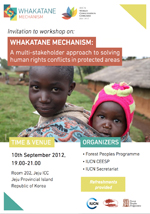
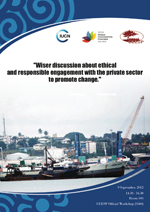
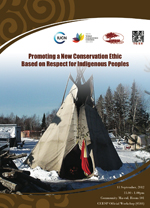
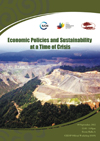
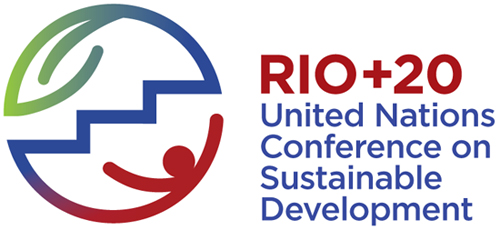
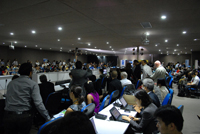 By now many of you will have read reports coming out of Rio+20 that characterize it as a failure. To fail, however, is always relative to the definition of success, and given the focus of Rio+20 on laying the groundwork for the production of a so-called 'Green Economy', failure might not be such a bad outcome. If only it could have failed without the sheer waste of resources that went into convening the event. It's difficult to imagine a more energy intensive gathering than what was experienced in Rio – the primary meeting venues hours from accommodation on traffic congested roads with little hope of using public transit to get to the site.
By now many of you will have read reports coming out of Rio+20 that characterize it as a failure. To fail, however, is always relative to the definition of success, and given the focus of Rio+20 on laying the groundwork for the production of a so-called 'Green Economy', failure might not be such a bad outcome. If only it could have failed without the sheer waste of resources that went into convening the event. It's difficult to imagine a more energy intensive gathering than what was experienced in Rio – the primary meeting venues hours from accommodation on traffic congested roads with little hope of using public transit to get to the site. 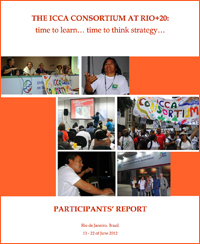
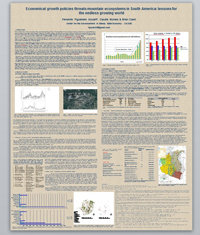 The Center for the Advancement for the Steady State Economy (CASSE) was invited to participate in an event at the framework of the UNCSD Rio+20 Conference: the Global Mountain Pavilion.
The Center for the Advancement for the Steady State Economy (CASSE) was invited to participate in an event at the framework of the UNCSD Rio+20 Conference: the Global Mountain Pavilion. 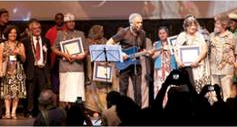 On Wednesday 20 June 2012, the Equator Prize 2012 Award Ceremony was held as part of the Rio+20 UN Conference on Sustainable Development in Rio de Janeiro, Brazil with a gala event at the Vivo Rio concert hall. Celebrating both the 10-year anniversary of the Equator Initiative and the 20-year anniversary of the UNDP-implemented GEF Small Grants Programme, the evening was a vibrant celebration of local action in thematic areas such as food security, freshwater access, sustainable energy, oceans and biodiversity.
On Wednesday 20 June 2012, the Equator Prize 2012 Award Ceremony was held as part of the Rio+20 UN Conference on Sustainable Development in Rio de Janeiro, Brazil with a gala event at the Vivo Rio concert hall. Celebrating both the 10-year anniversary of the Equator Initiative and the 20-year anniversary of the UNDP-implemented GEF Small Grants Programme, the evening was a vibrant celebration of local action in thematic areas such as food security, freshwater access, sustainable energy, oceans and biodiversity. 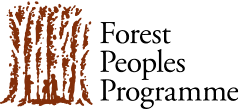 We live in a deeply divided world where growing inequalities, rising populations, coupled with heightened expectations and life-style demands, run into conflict with finite and depleting resources. Twenty years ago, at the first Rio Summit, it was agreed that a transition to ‘sustainable development’ was urgently required. Reviewing the results of the second Rio Summit (‘Rio+20’) held last month, most commentators agree that governments have not made the promised changes. In some respects the world has gone backwards, the message of ‘sustainable development’ having been replaced with a renewed obsession with ‘sustained growth’.
We live in a deeply divided world where growing inequalities, rising populations, coupled with heightened expectations and life-style demands, run into conflict with finite and depleting resources. Twenty years ago, at the first Rio Summit, it was agreed that a transition to ‘sustainable development’ was urgently required. Reviewing the results of the second Rio Summit (‘Rio+20’) held last month, most commentators agree that governments have not made the promised changes. In some respects the world has gone backwards, the message of ‘sustainable development’ having been replaced with a renewed obsession with ‘sustained growth’. 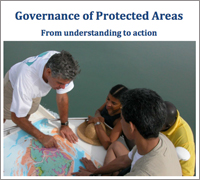 If you have any comments for the document, please send them to gbf to
If you have any comments for the document, please send them to gbf to 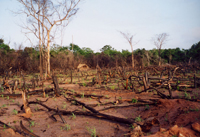 CEESP TGER Co-Chair Dr. Janis Bristol Alcorn is serving as a technical advisor for a new USAID-funded study of "Shifting Cultivation, Gender and REDD+ in West and Central Africa", being implemented by USAID´s Forest Carbon, Markets and Communities (FCMC) project in coordination with CARPE and STEWARD projects in West and Central Africa.
CEESP TGER Co-Chair Dr. Janis Bristol Alcorn is serving as a technical advisor for a new USAID-funded study of "Shifting Cultivation, Gender and REDD+ in West and Central Africa", being implemented by USAID´s Forest Carbon, Markets and Communities (FCMC) project in coordination with CARPE and STEWARD projects in West and Central Africa.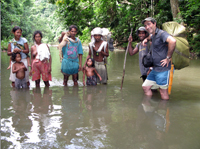 Following the IUCN World Conservation Congress at Barcelona, Dr. Dario Novellino - a CEESP member since 2008 - has been investing much efforts in facilitating the creation of audio-visual platforms for indigenous and rural communities to express their voices and, particularly, their own critiques of state policies, development and top-down conservation projects.
Following the IUCN World Conservation Congress at Barcelona, Dr. Dario Novellino - a CEESP member since 2008 - has been investing much efforts in facilitating the creation of audio-visual platforms for indigenous and rural communities to express their voices and, particularly, their own critiques of state policies, development and top-down conservation projects.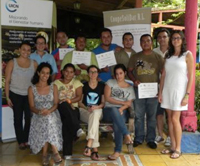 El taller "Agua, Cambio Climático y Zonas Costeras: Implicaciones para los jóvenes de comunidades de pesca artesanal en Centroamérica y México" se desarrolló como actividad preparatoria para el Congreso Mundial para la Naturaleza de la Unión Internacional para la Conservación de la Naturaleza (UICN) y en el marco del proyecto Gestión del Agua para la Adaptación de UICN, financiado por el Ministerio Federal del Medio Ambiente, la Conservación de la Naturaleza y la Seguridad Nuclear (BMU) de Alemania.
El taller "Agua, Cambio Climático y Zonas Costeras: Implicaciones para los jóvenes de comunidades de pesca artesanal en Centroamérica y México" se desarrolló como actividad preparatoria para el Congreso Mundial para la Naturaleza de la Unión Internacional para la Conservación de la Naturaleza (UICN) y en el marco del proyecto Gestión del Agua para la Adaptación de UICN, financiado por el Ministerio Federal del Medio Ambiente, la Conservación de la Naturaleza y la Seguridad Nuclear (BMU) de Alemania. 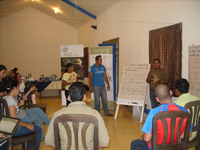 Seven young representatives from fishing communities of Central America and Mexico met in Tárcoles, Costa Rica, the 7th and 8th of June ( Oceans Day) , for a two day workshop, organized by UICN- Mesoamerican and Caribbean Regional Office, CoopeSoliDar R.L and CEESP and CEESP Youth, with the support of the organizations that nominated the young participants: ACRA (Nicaragua), Committee for the Defence and Development of the Flora and Fauna of the Fonseca Gulf- CODDEFFAGOLF (Honduras), CoopeTárcoles R.L. (Costa Rica), the Federation of Artisanal Fishing of Guatemala (FENAPESCA), and the Federation of Artisanal Fishing of El Salvador (FACOPADES).
Seven young representatives from fishing communities of Central America and Mexico met in Tárcoles, Costa Rica, the 7th and 8th of June ( Oceans Day) , for a two day workshop, organized by UICN- Mesoamerican and Caribbean Regional Office, CoopeSoliDar R.L and CEESP and CEESP Youth, with the support of the organizations that nominated the young participants: ACRA (Nicaragua), Committee for the Defence and Development of the Flora and Fauna of the Fonseca Gulf- CODDEFFAGOLF (Honduras), CoopeTárcoles R.L. (Costa Rica), the Federation of Artisanal Fishing of Guatemala (FENAPESCA), and the Federation of Artisanal Fishing of El Salvador (FACOPADES).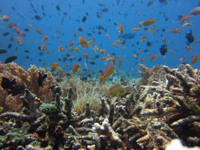 CEESP Member Antonio M Claparols provides this opinion piece for readers.
CEESP Member Antonio M Claparols provides this opinion piece for readers.  The Whakatane Mechanism, an IUCN "One Programme" initiative in which CEESP is deeply involved, aims to ensure that conservation policy and practice respect the rights of indigenous peoples and local communities, including those specified in the United Nations Declaration on the Rights of Indigenous Peoples (UNDRIP). It is a tool for the implementation of IUCN Resolution 4.052 and other resolutions taken by the WCC to respect the rights of indigenous peoples and local communities in conservation.
The Whakatane Mechanism, an IUCN "One Programme" initiative in which CEESP is deeply involved, aims to ensure that conservation policy and practice respect the rights of indigenous peoples and local communities, including those specified in the United Nations Declaration on the Rights of Indigenous Peoples (UNDRIP). It is a tool for the implementation of IUCN Resolution 4.052 and other resolutions taken by the WCC to respect the rights of indigenous peoples and local communities in conservation. 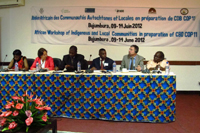 The following details TILCEPA's report back on CBD preparatory meeting for indigenous peoples in Africa, IUCN Congress Events and Sri Lanka Inter-religious Dialogue.
The following details TILCEPA's report back on CBD preparatory meeting for indigenous peoples in Africa, IUCN Congress Events and Sri Lanka Inter-religious Dialogue. 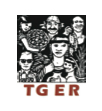 The objective of the CEESP TGER (Thematic group on Governance, Equity and Rights) is improved governance and equity through a rights-based approach to conservation. TGER has maintained a steady number of around 330 members from over 40 countries over the past four years.
The objective of the CEESP TGER (Thematic group on Governance, Equity and Rights) is improved governance and equity through a rights-based approach to conservation. TGER has maintained a steady number of around 330 members from over 40 countries over the past four years.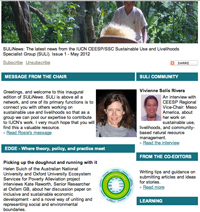 The Sustainable Use and Livelihoods Specialist Group launched its first newsletter in May and its members have been involved in the following activities:
The Sustainable Use and Livelihoods Specialist Group launched its first newsletter in May and its members have been involved in the following activities: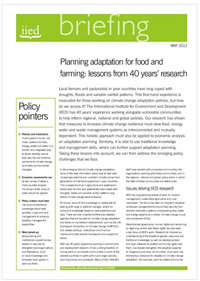 Local farmers and pastoralists in poor countries have long coped with droughts, floods and variable rainfall patterns.
Local farmers and pastoralists in poor countries have long coped with droughts, floods and variable rainfall patterns. 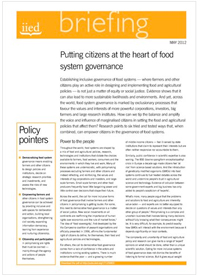 Establishing inclusive governance of food systems — where farmers and other citizens play an active role in designing and implementing food and agricultural policies — is not just a matter of equity or social justice. Evidence shows that it can also lead to more sustainable livelihoods and environments.
Establishing inclusive governance of food systems — where farmers and other citizens play an active role in designing and implementing food and agricultural policies — is not just a matter of equity or social justice. Evidence shows that it can also lead to more sustainable livelihoods and environments. 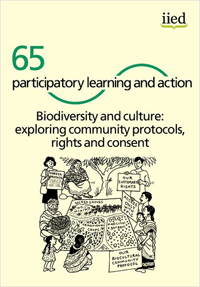 Participatory Learning and Action Issue 65, June 2012
Participatory Learning and Action Issue 65, June 2012

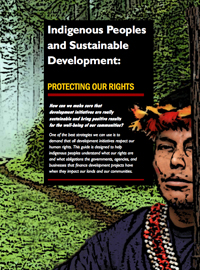 The guide addresses the question of how can we make sure that development initiatives are really sustainable and bring positive results for the well-being of indigenous communities.
The guide addresses the question of how can we make sure that development initiatives are really sustainable and bring positive results for the well-being of indigenous communities. 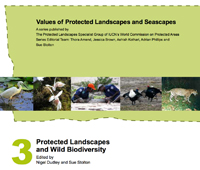 Protected landscapes and seascapes (IUCN category V) are protected areas where long established management systems play a critical conservation role in culturally-influenced ecosystems. Proponents claim that the category V approach can benefit both people and wildlife.
Protected landscapes and seascapes (IUCN category V) are protected areas where long established management systems play a critical conservation role in culturally-influenced ecosystems. Proponents claim that the category V approach can benefit both people and wildlife. 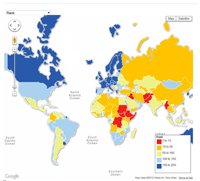 How safe are indigenous peoples around the world? This map shows country rankings according to the latest Peoples Under Threat index from Minority Rights Group International. South Sudan is the highest riser, although it has only just come into existence.
How safe are indigenous peoples around the world? This map shows country rankings according to the latest Peoples Under Threat index from Minority Rights Group International. South Sudan is the highest riser, although it has only just come into existence. 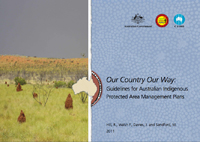 Our Country Our Way is an illustrated guide that can be used by anyone interested in developing a management plan for an Indigenous Protected Area. Indigenous Protected Area management plans are based on making connections between Indigenous people, country, traditional law, custom and culture with the Australian and international systems for protected area management.
Our Country Our Way is an illustrated guide that can be used by anyone interested in developing a management plan for an Indigenous Protected Area. Indigenous Protected Area management plans are based on making connections between Indigenous people, country, traditional law, custom and culture with the Australian and international systems for protected area management. 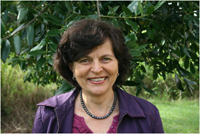 The International Journal of Science in Society 2 (4):181-194. CEESP member Rosemary Hill and colleagues published a Journal article reinforcing that worldwide there are examples of ecosystems that exist in their current state due to the complex interactions between people and the environment over time.
The International Journal of Science in Society 2 (4):181-194. CEESP member Rosemary Hill and colleagues published a Journal article reinforcing that worldwide there are examples of ecosystems that exist in their current state due to the complex interactions between people and the environment over time. 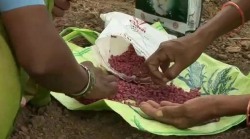 We sometimes lose sight of the fact that Big Ag's influence extends far beyond our own borders. Micha Peled's documentary Bitter Seeds is a stark reminder of that fact. Bitter Seeds exposes the havoc Monsanto has wreaked on rural farming communities in India, and serves as a fierce rebuttal to the claim that genetically modified seeds can save the developing world. The film follows Manjusha, whose father was one of the quarter-million farmers who have committed suicide in India in the last 16 years.
We sometimes lose sight of the fact that Big Ag's influence extends far beyond our own borders. Micha Peled's documentary Bitter Seeds is a stark reminder of that fact. Bitter Seeds exposes the havoc Monsanto has wreaked on rural farming communities in India, and serves as a fierce rebuttal to the claim that genetically modified seeds can save the developing world. The film follows Manjusha, whose father was one of the quarter-million farmers who have committed suicide in India in the last 16 years. 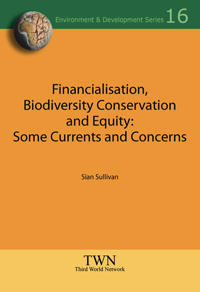 WHEN nature is viewed in monetary terms, is it the nature that is valued, or the money? And what implications does this have for ecosystems and equity, given a financialised economy that rewards money products and their brokers, and that tends towards speculative and volatile dynamics?
WHEN nature is viewed in monetary terms, is it the nature that is valued, or the money? And what implications does this have for ecosystems and equity, given a financialised economy that rewards money products and their brokers, and that tends towards speculative and volatile dynamics?  In the summer issue of the Journal of Enterprising Communities (Volume 6, Issue 3) a set of papers presented at the CEESP Sharing Power Conference in Whakatane, New Zealand has been published. The special issue includes three cases from a Canadian research project along with other papers presented at the conference and considers Indigenous perspectives on product and service development for the bioeconomy within the broader context of Indigenous enterprises for natural resource development.
In the summer issue of the Journal of Enterprising Communities (Volume 6, Issue 3) a set of papers presented at the CEESP Sharing Power Conference in Whakatane, New Zealand has been published. The special issue includes three cases from a Canadian research project along with other papers presented at the conference and considers Indigenous perspectives on product and service development for the bioeconomy within the broader context of Indigenous enterprises for natural resource development.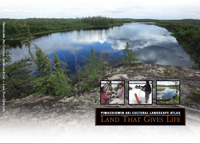 CEESP recently supported the publication of the Pimachiowin Aki "The Land that Gives Life" Cultural Landscape Atlas. This atlas was written to increase public understanding of the relationship between the land and First Nation Peoples of the boreal shield in Canada. The atlas also provides an accessible overview of world heritage sites and cultural landscapes. Most importantly, it highlights the leadership of the First Nations in building partnerships to support their vision of a world heritage site and why such sites should recognize First Nation custodianship of their traditional territories.
CEESP recently supported the publication of the Pimachiowin Aki "The Land that Gives Life" Cultural Landscape Atlas. This atlas was written to increase public understanding of the relationship between the land and First Nation Peoples of the boreal shield in Canada. The atlas also provides an accessible overview of world heritage sites and cultural landscapes. Most importantly, it highlights the leadership of the First Nations in building partnerships to support their vision of a world heritage site and why such sites should recognize First Nation custodianship of their traditional territories.




